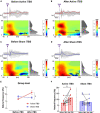Intermittent Theta Burst Stimulation Increases Natural Oscillatory Frequency in Ipsilesional Motor Cortex Post-Stroke: A Transcranial Magnetic Stimulation and Electroencephalography Study
- PMID: 35197845
- PMCID: PMC8859443
- DOI: 10.3389/fnagi.2022.818340
Intermittent Theta Burst Stimulation Increases Natural Oscillatory Frequency in Ipsilesional Motor Cortex Post-Stroke: A Transcranial Magnetic Stimulation and Electroencephalography Study
Abstract
Objective: Intermittent theta burst stimulation (iTBS) has been widely used as a neural modulation approach in stroke rehabilitation. Concurrent use of transcranial magnetic stimulation and electroencephalography (TMS-EEG) offers a chance to directly measure cortical reactivity and oscillatory dynamics and allows for investigating neural effects induced by iTBS in all stroke survivors including individuals without recordable MEPs. Here, we used TMS-EEG to investigate aftereffects of iTBS following stroke.
Methods: We studied 22 stroke survivors (age: 65.2 ± 11.4 years; chronicity: 4.1 ± 3.5 months) with upper limb motor deficits. Upper-extremity component of Fugl-Meyer motor function assessment and action research arm test were used to measure motor function of stroke survivors. Stroke survivors were randomly divided into two groups receiving either Active or Sham iTBS applied over the ipsilesional primary motor cortex. TMS-EEG recordings were performed at baseline and immediately after Active or Sham iTBS. Time and time-frequency domain analyses were performed for quantifying TMS-evoked EEG responses.
Results: At baseline, natural frequency was slower in the ipsilesional compared with the contralesional hemisphere (P = 0.006). Baseline natural frequency in the ipsilesional hemisphere was positively correlated with upper limb motor function following stroke (P = 0.007). After iTBS, natural frequency in the ipsilesional hemisphere was significantly increased (P < 0.001).
Conclusions: This is the first study to investigate the acute neural adaptations after iTBS in stroke survivors using TMS-EEG. Our results revealed that natural frequency is altered following stroke which is related to motor impairments. iTBS increases natural frequency in the ipsilesional motor cortex in stroke survivors. Our findings implicate that iTBS holds the potential to normalize natural frequency in stroke survivors, which can be utilized in stroke rehabilitation.
Keywords: TMS-EEG; evoked oscillatory response; intermittent theta burst stimulation; natural frequency; stroke rehabilitation.
Copyright © 2022 Ding, Chen, Chen, Zhang, Peng, Chen, Chen, Li, Chen, Cai, Xu and Lan.
Conflict of interest statement
The authors declare that the research was conducted in the absence of any commercial or financial relationships that could be construed as a potential conflict of interest.
Figures






Similar articles
-
The effectiveness of intermittent theta burst stimulation for upper limb motor recovery after stroke: a systematic review and meta-analysis of randomized controlled trials.Front Neurosci. 2023 Oct 12;17:1272003. doi: 10.3389/fnins.2023.1272003. eCollection 2023. Front Neurosci. 2023. PMID: 37901439 Free PMC article.
-
The Effects of Intermittent Theta Burst Stimulation on Functional Brain Network Following Stroke: An Electroencephalography Study.Front Neurosci. 2021 Oct 22;15:755709. doi: 10.3389/fnins.2021.755709. eCollection 2021. Front Neurosci. 2021. PMID: 34744616 Free PMC article.
-
Immediate Effects of Intermittent Theta Burst Stimulation on Primary Motor Cortex in Stroke Patients: A Concurrent TMS-EEG Study.IEEE Trans Neural Syst Rehabil Eng. 2023;31:2758-2766. doi: 10.1109/TNSRE.2023.3282659. Epub 2023 Jun 23. IEEE Trans Neural Syst Rehabil Eng. 2023. PMID: 37276099 Clinical Trial.
-
Efficacy of coupling intermittent theta-burst stimulation and 1 Hz repetitive transcranial magnetic stimulation to enhance upper limb motor recovery in subacute stroke patients: A randomized controlled trial.Restor Neurol Neurosci. 2020;38(1):109-118. doi: 10.3233/RNN-190953. Restor Neurol Neurosci. 2020. PMID: 32039879 Clinical Trial.
-
Excitatory Repetitive Transcranial Magnetic Stimulation Over the Ipsilesional Hemisphere for Upper Limb Motor Function After Stroke: A Systematic Review and Meta-Analysis.Front Neurol. 2022 Jun 20;13:918597. doi: 10.3389/fneur.2022.918597. eCollection 2022. Front Neurol. 2022. PMID: 35795793 Free PMC article.
Cited by
-
The effectiveness of intermittent theta burst stimulation for upper limb motor recovery after stroke: a systematic review and meta-analysis of randomized controlled trials.Front Neurosci. 2023 Oct 12;17:1272003. doi: 10.3389/fnins.2023.1272003. eCollection 2023. Front Neurosci. 2023. PMID: 37901439 Free PMC article.
-
Effect of theta burst stimulation on lower extremity motor function improvement and balance recovery in patients with stroke: A systematic review and meta-analysis of randomized controlled trials.Medicine (Baltimore). 2024 Nov 1;103(44):e40098. doi: 10.1097/MD.0000000000040098. Medicine (Baltimore). 2024. PMID: 39495989 Free PMC article.
-
Individual differences in beta-band oscillations predict motor-inhibitory control.Front Neurosci. 2023 Mar 1;17:1131862. doi: 10.3389/fnins.2023.1131862. eCollection 2023. Front Neurosci. 2023. PMID: 36937674 Free PMC article.
-
The role of brain oscillations in post-stroke motor recovery: An overview.Front Syst Neurosci. 2022 Jul 29;16:947421. doi: 10.3389/fnsys.2022.947421. eCollection 2022. Front Syst Neurosci. 2022. PMID: 35965998 Free PMC article. Review.
-
Using TMS-EEG to assess the effects of neuromodulation techniques: a narrative review.Front Hum Neurosci. 2023 Aug 14;17:1247104. doi: 10.3389/fnhum.2023.1247104. eCollection 2023. Front Hum Neurosci. 2023. PMID: 37645690 Free PMC article. Review.
References
LinkOut - more resources
Full Text Sources

